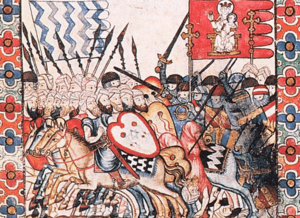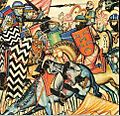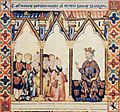Reconquista facts for kids
Quick facts for kids Reconquista |
|||||||
|---|---|---|---|---|---|---|---|
|
Moorish and Christian Reconquista battle, taken from the Cantigas de Santa María |
|||||||
|
|||||||
| Belligerents | |||||||
|
|
||||||
The Reconquista was a long period in the Middle Ages when Christian kingdoms in the Iberian Peninsula fought to take back land from Muslim states. The word "Reconquista" means "reconquest" in both Spanish and Portuguese. This important time lasted for almost 800 years, from 711 to 1492.
During the Reconquista, Christian rulers slowly expanded their territories. They pushed the Muslim states, known as al-Andalus, out of the peninsula. This period began not long after Muslim armies first arrived in Iberia. Many people saw fighting in the Reconquista as a religious duty, similar to the Crusades. Soldiers from all over Christendom came to Spain to join the fight.
The Reconquista finally ended on January 2, 1492. On this day, the city of Granada was captured. Granada was the last Muslim kingdom in Iberia. Its last Muslim ruler gave up his kingdom to Ferdinand II of Aragon and Isabella I of Castile. These two rulers were known as the "Catholic Monarchs." The fall of Granada marked the complete end of Muslim rule in the Iberian Peninsula.
Contents
What Was the Reconquista?
The Reconquista was a series of military campaigns. Christian kingdoms aimed to reclaim control of the Iberian Peninsula. This land had been largely under Muslim rule since the 8th century. The goal was to restore Christian rule across the region.
Who Was Involved?
On one side were several Christian kingdoms. These included the Kingdom of Asturias, which later became the Kingdom of León. Other major Christian powers were the Kingdom of Castile, the Kingdom of Navarre, the Kingdom of Aragon, and the Kingdom of Portugal. These kingdoms often worked together, but sometimes they fought among themselves.
On the other side were various Muslim states. These included the powerful Umayyad Caliphate and later the Caliphate of Córdoba. As time went on, smaller Muslim states called taifas appeared. Later, strong North African Muslim empires like the Almoravid dynasty and the Almohad Caliphate also played a big role. The last Muslim state was the Emirate of Granada.
Why Did It Happen?
The Reconquista started after the Islamic conquest of the Iberian Peninsula in the early 8th century. Christian leaders saw it as their mission to take back the land. They believed it belonged to Christian rule. Over centuries, this idea grew stronger. It became a powerful reason for people to fight.
Key Events and Turning Points
The Reconquista was not one continuous war. It was a long series of battles, sieges, and treaties. There were times of intense fighting and times of peace. Sometimes, Christian and Muslim rulers even formed alliances with each other.
Important Battles
One very important battle was the Battle of Las Navas de Tolosa in 1212. In this battle, a large army of Christian kingdoms defeated the Almohad Caliphate. This victory was a major turning point. It greatly weakened Muslim power in Iberia. It also opened the way for Christian armies to advance further south.
The Fall of Granada
The final stage of the Reconquista focused on the Emirate of Granada. This was the last remaining Muslim stronghold. In 1492, the Catholic Monarchs, Ferdinand and Isabella, launched a major campaign. After a long siege, Granada surrendered. This event completed the Reconquista. It united most of the Iberian Peninsula under Christian rule.
Life During the Reconquista
Life during this period was complex. While there was conflict, there were also times of coexistence. In many areas, Christians, Muslims, and Jews lived side-by-side. They shared ideas, knowledge, and culture. This led to advancements in science, art, and philosophy.
However, as the Reconquista progressed, religious differences became more pronounced. After the fall of Granada, new policies were put in place. These included the Alhambra Decree, which forced Jewish people to convert to Christianity or leave Spain. Later, similar pressures were put on Muslims.
Legacy of the Reconquista
The Reconquista had a huge impact on the history of Spain and Portugal. It shaped their borders and their cultures. It also led to the formation of powerful new kingdoms. These kingdoms would later explore and colonize new lands around the world. The Reconquista remains a very important part of the history of the Iberian Peninsula.
Images for kids
-
Depiction of battle, taken from the Cantigas de Santa Maria
-
The Islamic Almohad Caliphate and surrounding states, including the Christian Kingdoms of Portugal, Leon, Castile, Navarre, and the Crown of Aragon, around 1200.
-
The Caliphate of Córdoba in the early 10th century.
-
Saint James the Great depicted as Saint James the Moor-slayer. A legend of the Reconquista.
-
Ceramic of the conquest of Toledo by Alfonso VI.
-
The Moors request permission from James I of Aragon.
-
The Battle of the Puig at El Puig de Santa Maria in 1237.
-
Capture of Seville by Ferdinand III of Castile (painted by Francisco Pacheco).
-
The Surrender of Granada by Francisco Pradilla Ortiz.
-
The Battle of Las Navas de Tolosa (1212), an important turning point of the Reconquista.
-
Forces of Muhammed IX, Nasrid Sultan of Granada, at the Battle of La Higueruela, 1431.
-
Moros y Cristianos festival in Pego, Alicante, 2016.
-
The Portuguese forces, commanded by King Afonso V, in the conquest of Asilah, Morocco, 1471, from the Pastrana Tapestries.
See also
 In Spanish: Reconquista para niños
In Spanish: Reconquista para niños




















